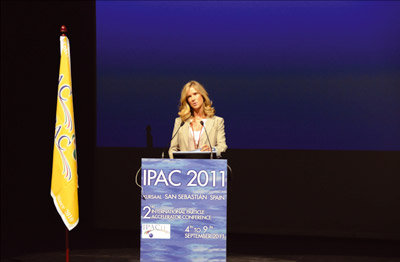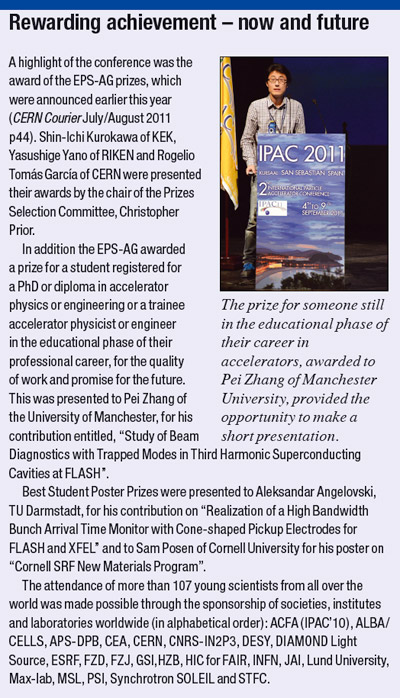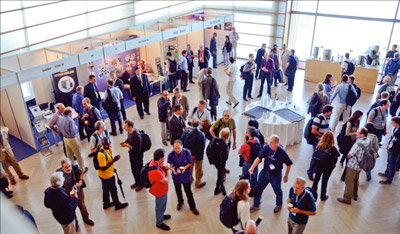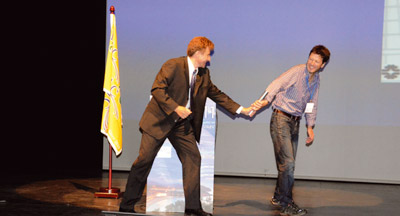A report from the 2nd International Particle Accelerator Conference.
Résumé
IPAC’11 réuni à Saint-Sébastien
Tous les trois ans, c’est l’Europe qui accueille la Conférence internationale sur les accélérateurs de particules (IPAC), qui a lieu tous les ans ; l’Asie et l’Amérique prennent le relais les autres années. IPAC’11, deuxième conférence de la série, a attiré quelque 1100 participants d’environ 30 pays, dont environ la moitié venait d’Europe et la moitié d’Asie et d’Amérique du Nord. À cette occasion, ils ont pu échanger sur différents sujets, tels que les sources de lumière synchrotron, les lasers à électron libre, les accélérateurs de hadrons, les collisionneurs et les applications des accélérateurs.

Three years ago the last in the series of European Particle Accelerator Conferences took place in the Italian seaport of Genoa. Now, reflecting the increasingly worldwide nature of the subject, Europe plays host every three years to the new International Particle Accelerator Conference (IPAC) series, with Asia and North America taking turns in the other two years. Following a successful first meeting in Kyoto in 2010, this year it fell to Europe to organize the 2nd IPAC and once again accelerator specialists found themselves by the sea, this time at San Sebastián on Spain’s Atlantic coast. There, on 4–9 September, the sea and surf provided a fitting setting for a meeting where wave motion figured in many presentations.

Image credit: Terry Pritchard.
The Kursaal conference centre on the water’s edge was an ideal place to house the sessions for around 1100 participants. As at many conferences these consist of plenary, parallel and poster sessions but the balance at IPAC – as at the regional conferences held in the past – makes for a different mixture. A pair of parallel sessions provides a straight choice between two oral presentations, allowing much of the “business” of the conference to occur in busy afternoon poster sessions, which cover different topics each day. These are like scientific bazaars where vendors show off their wares to anyone interested and information is traded freely.
IPAC’11 was truly international, with participants from some 30 countries, around half from Europe and the other half from Asia and North America. The programme spanned four and a half days, with plenary sessions on two mornings, as well as on one afternoon. The two parallel sessions took place on other mornings and afternoons, with the poster sessions (supplied with plenty of refreshments) scheduled alone at the end of four afternoons. Altogether, 1300 posters were scheduled, which is a clear indication of the vibrancy of the field. A special poster session for young scientists – with a prize for the best two – took place on the first day during registration (see box).
At the opening plenary session the Spanish minister of science and innovation, Cristina Garmendia, welcomed participants to the Basque country – her home region – and drew attention to Spain’s increasing involvement in accelerator science. ALBA, the synchrotron light source near Barcelona, was the topic of the first of the session of invited talks, which went on to highlight a leading facility in the areas of hadron accelerators (the Japan Proton Accelerator Research Complex, J-PARC), circular colliders (the LHC), linear colliders (the International Linear Collider, ILC) and synchrotron light sources and FELs (the Japanese-XFEL at SPring-8). These were four of the main themes for the conference, the others being accelerator technology, beam instrumentation and feedback, beam dynamics and electromagnetic fields, as well as applications of accelerators.
The presentations on light sources served to demonstrate just how far and wide accelerator technology has spread to provide valuable research tools for other areas of science. ALBA, built and operated by the CELLS consortium, is based on a 3 GeV booster synchrotron that feeds a storage ring located in the same tunnel (CERN Courier November 2008 p31). The storage ring accumulated first beam on 16 March and by 7 June had achieved a current of 170 mA in readiness for beamline commissioning. Other similar synchrotron-based facilities that are now being designed elsewhere include the Polish facility Solaris and the Iranian Light Source Facility. The design of Sirius, at the Brazilian Synchrotron Light Laboratory, São Paulo, takes a slightly different approach. The dipoles of the 3 GeV ring will be based on permanent magnet technology – for reduced operational costs and increased reliability – and it will combine low-field magnets (0.5 T) for guiding the main beam with short “slices” of high-field magnets (2.0 T) to generate 12 keV photons for the beamlines.
Synchrotron light sources are now being joined increasingly by facilities that use FELs to produce light at ever decreasing wavelengths. In Italy, for example, the 2.4 GeV Elettra synchrotron light source is being supplemented by FERMI, an externally seeded soft X-ray FEL. Its first seeded FEL coherent output at 43 nm, achieved last December, was followed by commissioning of the beamlines and the first tests with users in March and April. In Japan, the SPring-8 Angstrom Compact free electron LAser (SACLA) is the world’s first compact X-ray FEL based on in-vacuum undulators. Commissioning started there in February and the FEL produced its first X-ray laser light at 0.12 nm on 7 June (CERN Courier July/August 2011 p9). In the UK, meanwhile, the ALICE Accelerator R&D Facility at Daresbury, has built Europe’s first FEL to be driven by a superconducting energy-recovery linac. The infrared FEL achieved lasing for the first time in October 2010. ALICE is also a source of high-power terahertz radiation, which has potential use in studies of living cells. In June, beam was transferred to a tissue-culture laboratory some 30 m from the accelerator.
Hadron power
While electron accelerators find applications in light sources, hadron accelerators have a role as powerful drivers for a range of facilities. J-PARC, for example, is a multipurpose proton accelerator facility aiming ultimately at an output beam power in the megawatt range. Commissioning started with the 400 MeV H– linac in November 2006 and by 2011 output beam power from the 3 GeV Rapid-Cycling Synchrotron to the Materials and Life Science Facility had reached 220 kW and a 145 kW beam was produced by fast extraction from the Main Ring for neutrino production. This progress came to an abrupt halt in March when the massive earthquake struck the north-east of Japan. With its epicentre 270 km from J-PARC, the magnitude 9.0 event caused subsidence of up to 1.5 m at the entrance to the linac but – although the tunnel floor was deformed by as much as 45 mm – the linac structures did not topple. Simulations have shown that misalignment of up to 0.2 mm in the drift-tube quadrupoles can be tolerated by compensating with beam steering. This is speeding up recovery because only the drift-tube structures with the most essential realignment need to be opened up. Beam tests following recovery are planned for December, with a restart in January 2012.
Spallation neutron sources require powerful proton accelerators to drive them. The China Spallation Neutron Source is being designed to operate with an initial proton beam power of 100 kW, upgradeable to 500 kW. Construction was scheduled to start in September and should take six and a half years. It is the first large-scale, high-power accelerator project to be constructed in China.

In Europe, there is a growing need for a new high-flux source of cold neutrons because many research reactors are scheduled to close in the coming decade. The European Spallation Neutron Source (ESS) to be built in Lund should fill this gap. In terms of proton energy, its requirements are modest – 2.5 GeV – but the challenges will come in providing the 5 MW beam power and the 50 mA current in 2.9 ms pulses at 14 Hz. As many as 17 countries are involved in the accelerator development, with a target date of 2020 for first operation.
High-power proton accelerators are equally important for future high-intensity neutrino sources. In Europe the EC has funded EUROnu, a design study to investigate three options for a future high-intensity neutrino oscillation facility: a CERN to Frejus Super-Beam, a Neutrino Factory and a Beta Beam. At CERN, meanwhile, Linac 4 represents the first step in a long-term programme to increase luminosity in the LHC. Civil engineering for a new building has recently finished and construction of the main accelerator components for the 160 MeV H– linac has started with the support of a network of international collaborations. Linac 4 should double the intensity from the Proton Synchrotron Booster; commissioning is currently planned for 2013–2014.
Frontier colliders
At IPAC’11 the LHC had a starring role as a circular collider. It passed the peak luminosity record of the Tevatron – its predecessor as the world’s highest-energy collider – on 21 April and has since gone on to deliver more than 5 fb–1 integrated luminosity to the ATLAS and CMS experiments. As the world’s first superconducting accelerator, the Tevatron blazed an important pioneering trail, which was reviewed by Fermilab’s Vladimir Shiltsev after passing a symbolic baton to Mike Lamont, head of the Operations Group at CERN. While the spotlight is now on physics at the LHC, the accelerator experts are looking increasingly towards the future with upgrades to take the luminosity to an average of 5 × 1034 cm–2 s–1 in the High-Luminosity LHC project. The main goal is to reach 3000 fb–1 of accumulated luminosity in the 10–12 years following the upgrade.

One of the issues with increasing energy (and intensity) in hadron beams concerns collimation. Crystal collimation has been studied for a number of years at CERN. Most recently, tests by the UA9 experiment at the Super Proton Synchrotron show that halo collimation with bent crystals could help to enhance collimation efficiency at the LHC. Another novel idea uses a hollow low-energy electron beam in which the proton halo experiences non-linear transverse kicks. This requires a special electron gun to create the hollow beam; tests with mainly antiprotons have already taken place at Fermilab.
In parallel to the LHC luminosity upgrade, plans are being studied to transform the LHC into the LHeC – a high-luminosity electron–nucleon collider of 1.3 TeV centre-of-mass energy (CERN Courier April 2009 p22). This could be achieved by adding a 60 GeV electron ring or linear accelerator to the existing proton and ion facility; it would complement the LHC’s physics potential and build on the existing LHC investments and its high-luminosity upgrade.
Circular electron colliders have been at the intensity frontier for a number of years, in particle “factories”. With KEKB and PEP II reaching peak luminosities of 1034 cm–2 s–1 they delivered a combined integrated luminosity of more than 1 inverse attobarn (1 ab–1). Now the aim is to go 50 times higher, with two facilities, SuperB in Italy and SuperKEKB in Japan. Large crossing-angles are a common feature for increased luminosity. At lower energies, a technique using round beams is being developed to give higher luminosities at the VEPP2000 facility at the Budker Institute of Nuclear Physics in Novosibirsk.

The high-energy frontier with electron machines rests with a linear collider. The ILC and Compact Linear Collider (CLIC) design studies exemplify the necessary international approach (CERN Courier December 2010 p7). Excellent results have demonstrated the feasibility of the CLIC concept for a high-energy linear collider based on the two-beam scheme and normal conducting RF cavities. These concepts and results will be the basis for the CLIC Conceptual Design Report to be completed in 2012. Another technology that could be key, developed in the context of the ILC design study, is superconducting RF and a 9-cell cavity is undergoing intensive R&D around the world. As many as 14 560 such cavities would be required for an eventual machine, housed in 1680 cryomodules. So far some 12 cryomodules have been made, with one from KEK operating at more than 35 V/m in tests.
R&D for the ILC is having spin-off in other research areas, for example, in rare isotope production. This is typically an application for high-power proton beams, but at TRIUMF, the Advanced Rare Isotope Laboratory will couple proton-induced spallation with electron-driven photo-fission for the production of proton-rich isotopes below the line of stability. The latter requires an electron linac delivering 0.5 MW to give some 104 fissions per second and the plan is to use 9-cell 1.3 GHz cavities developed for the ILC.
Although the frontiers of fundamental particle physics may drive the push particularly to higher energy accelerators, IPAC is a showcase for the applied side of this research and its close links with industry. An industrial exhibition on the first three days of the conference allowed 76 companies to present their hi-tech products and services. A special session on “Spanish Science Industry” also took place one evening.
Hadron therapy is one high-profile application of particle accelerators that now has close links with industry (Hadron therapy: collaborating for the future). In the final session, invited speaker Koji Noda, of the National Institute of Radiological Sciences (NIRS) in Japan, reviewed accelerator and beam-delivery technologies for hadron-therapy facilities around the world. The number of facilities is set to grow from around 30 to more than 50 in the coming decade, thanks to the development of suitable technologies. These include gated irradiation linked to beam extraction, which can switch the beam on or off within a millisecond in response to breathing – one of several techniques pioneered in Japan. For the future more compact machines have the potential to reduce costs, for example, with laser-ion acceleration or with fixed-field alternating gradient (FFAG) machines. Another interesting development centres on the non-scaling FFAG concept, using permanent magnets for a compact proton accelerator.
In another talk that showed that the field has social awareness, Colin Carlile posed the question: “Is it possible to operate a large research facility with wind power?” The answer seems to be, “yes, to a certain degree”. As director-general of the ESS he is in a position to lead by example and showed schemes to reduce electricity consumption from 350 GW to 250 GW, with CO2 savings of 165,000 tonnes each year. A final, sobering note for the conference came from John Duncan, until recently the UK Ambassador for Arms Control and Disarmament, with his talk “Towards a World Without Nuclear Weapons: How can Scientists Help?”

The success of IPAC’11 was a result of the excellent collaboration between the international teams of the Organizing Committee and the Scientific Programme Committee, and the Local Organizing Committee. The large number of participants and the enthusiasm shown in San Sebastián indicate the strong mandate for the IPAC series from the worldwide accelerator community. This community will be looking forward to the next edition, which will take place in New Orleans on 20–25 May 2012.
• IPAC’11 was organized under the auspices of the European Physical Society Accelerator Group (EPS-AG) and the International Union of Pure and Applied Sciences (IUPAP). The proceedings of IPAC’11 are published on the JACoW site: www.jacow.org. Thanks to the JACoW team of seasoned experts and freshly trained volunteers, led by Christine Petit-Jean-Genaz of CERN, a pre-press version with 1236 contributions was published five days after the conference. The final version was published on the site just three weeks after the conference – yet another impressive record set by the JACoW collaboration.








